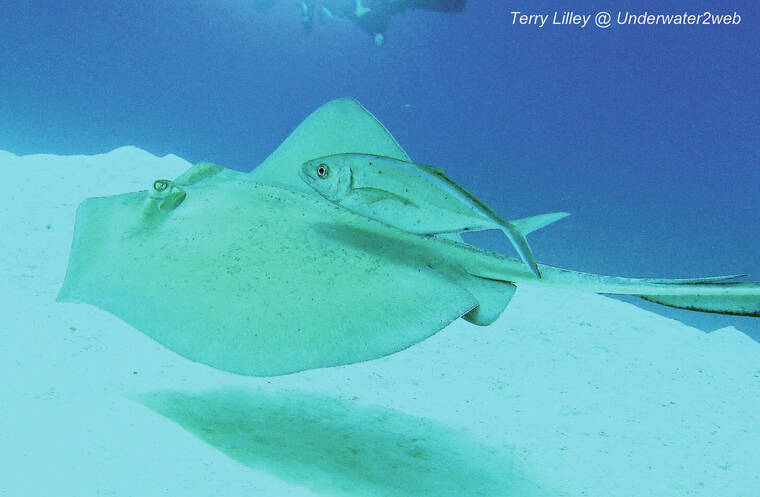The broad stingray is fairly common in Hawai‘i, but rarely seen by divers and snorkelers because it likes to feed in calm bays where the visibility is not very good. This solid-gray ray can get quite big, with a 5-foot wide wingspan.
It is often confused with hihimanu the eagle ray, which is more of a black color with white spots. Both the broad stingray and eagle ray have a venomous barbed spine mounted at the base of a whip-like tail, and they can cause an extremely painful wound if you step on one.
Both the broad stingray and eagle ray are harmless to people if you don’t get closer than about 10 feet from one. Steve Irwin from the Crocodile Hunter TV show got killed by a giant stingray!
He was filming an underwater scene with a giant stingray and diving right up above the ray when the fish got startled and whipped its tail upward, hitting Irwin in the chest. The wound from a big ray should not be fatal as long as you don’t try to remove the embedded spine because it is barbed and the more you move it the spine goes deeper into your flesh.
Irwin tried to remove the spine when he got back to the boat, and doing so caused the spine to go deeper into his body, which punctured his heart. Anyone who gets stung by a stingray should remain calm and get medical attention.
The broad stingray feeds on the sandy or muddy sea floor, and they use electromagnetic receptors that are under their nose to locate prey that lives under the sand. They feed on hidden fish, crabs and clams by using their head to dig holes in the sand until they locate their prey.
You can always tell that a large ray has been feeding because it will leave behind a crater in the sea floor. Often you will see a large jack swimming right above the ray so when the ray uncovers a food item from under the sand the jack zooms in and steals it.
Stingrays are similar to sharks because they lack a hard, bony skeleton, and their body is made up of cartilage that can easily bend. The only hard bones they have are their teeth, and sometimes people find those washed up on the beach and are confused as to what they have found.
You can see the giant broad stingray in action in my Koloa Landing documentary underwater movie up on my YouTube at Underwater2web.
•••
Terry Lilley is a marine biologist living in Hanalei. He is co-founder of Reef Guardians Hawai‘i, a nonprofit on a mission to provide education and resources to protect the coral reef. To donate to Reef Guardians Hawai‘i go to www.reefguardianshawaii.org.



